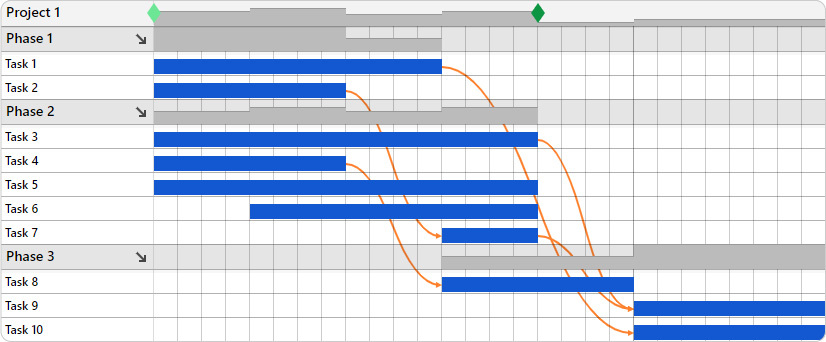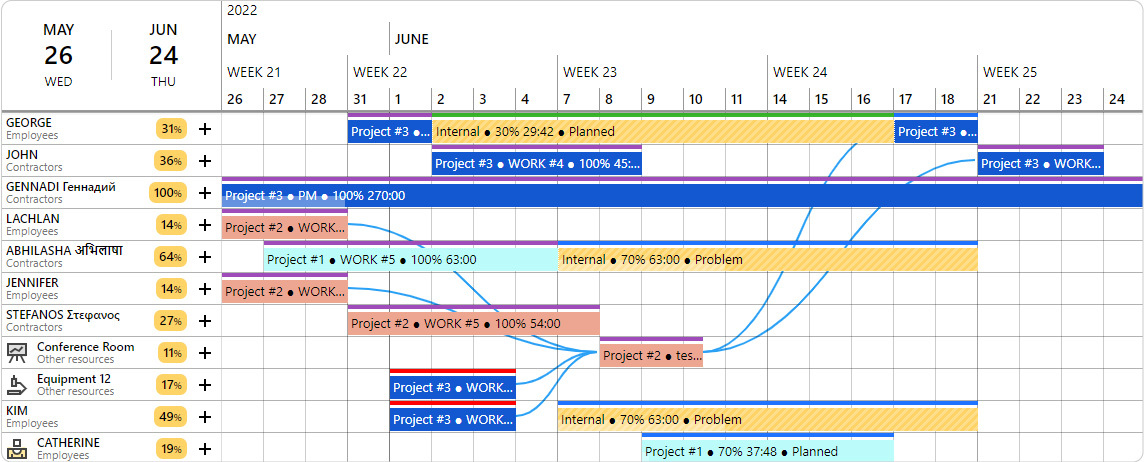Is your project resource management process not what it used to be? Maybe you’re noticing more mistakes or resourcing conflicts. Or perhaps you’re experiencing more project delays these days. If so, it might be time to revamp the way in which you’re managing projects’ resources. Here we’ll delve into a resource breakdown structure (RBS). Explaining what it is and how project managers can begin making their own.
What is a resource breakdown structure (RBS)?
First things, first, a resource breakdown structure (RBS) is not a work breakdown structure (WBS)
However, the RBS is a close cousin to the more commonly found work breakdown structure (WBS). This process, also done during the project planning stage, defines the project’s tasks and activities. With little to no focus on who is carrying out the work.
Instead, A resource breakdown structure is a hierarchical and often visual representation of all the resources needed to complete a project’s goals. This typically includes human resources, materials, equipment, facilities and even finances. It’s more in depth than a resource schedule, because it often takes into account the utilization, budget, and task priorities.
But using both is highly encouraged! Since the RBS tells you how these activities will be carried out. Helping to mitigate risks and extra costs that might pop up along the way.
RBS Vs WBS
While we can tell you difference between these 2 project management plans, it’s easier to visualize the difference. As they say, seeing is believing!
A traditional WBS is more about the steps needed to achieve project goals. These steps are the different tasks in the workflow. As demonstrated by the image, a WBS shows the tasks, their durations, and the milestones, dependencies, and phases of the project. Essentially showing you all the steps that need to be done along the way. Here, the “what” and “how long” are the most important details.
 A WBS created in Ganttic. This is a visual representation of all the projects’s main activities and important deadlines.
A WBS created in Ganttic. This is a visual representation of all the projects’s main activities and important deadlines.
Am RBS on the other hand is showing you the “who’s” and the “how’s.” Which team members are doing the job, and how will this work get completed. While it’s also important to see the tasks and deadlines, it’s more about having the right amount of manpower and tools to make a project’s deliverables a reality.
 A resource breakdown structure created in Ganttic. Here we see the utilization and the resources involved each step of the way.
A resource breakdown structure created in Ganttic. Here we see the utilization and the resources involved each step of the way.
Why is an RBS important in project management?
We mentioned before that it’s important to utilize both a resource and a project breakdown structure. That’s because they each bring their own value and show you 2 sides of the same coin.
There’s plenty of reasons why resource management is so important, but in terms of benefits for your business, here’s some of the top things which a properly implemented resource breakdown structure will help you achieve.
Improved Productivity
When resources are utilized optimally, projects are completed more efficiently. Instead of people having too much to do, or expensive machinery sitting by idly and unused, managers can be assured that all their resources are being used in the best way. This leads to better results for the organization in general. Because when you’re resources are used in a smarter way, not only will you see a happier workplace, but higher overall productivity.
Better Cost Control
By tracking resource usage and associated costs, your business can gain insights into resource expenses. This allows you to make more informed decisions on ways to control costs, prevent overspending, and identify areas where budget adjustments may be necessary.
Enhanced Project Planning
With the right resource management solution, organizations can assess resource availability and capacity beforehand. This ensures that projects are realistic in terms of timelines and resource requirements. And reduces the likelihood of delays.
Efficient Risk Management
By having a clear view of resource constraints and potential bottlenecks, organizations can peek into the future and take steps to mitigate risks. Meaning yow know ahead of time if there’s a potential problem. Then proactively address challenges and take preventive measures.
Improved Decision Making
Comprehensive resource data empowers decision-makers to make informed choices about project prioritization, resource investments, and strategic planning. These data-driven decisions lead to better outcomes and support the organization’s long-term goals.
Better Team & Stakeholder Communication
Resource management provides accurate information on project progress, resource utilization, and resource availability. Having such transparency enables effective communication with stakeholders, clients, and team members. And helps foster trust, while ensuring everyone is on the same page.
More Sustainable Growth
By efficiently managing resources and avoiding resource bottlenecks, organizations can achieve sustainable growth without putting excessive strain on their teams, finances, or infrastructure.
When do you need a resource breakdown structure?
Simply start by asking yourself one simple question. What would you like to see be differently?
It’s kind of like going to the doctor. Since you can’t get your diagnosis without looking at the symptoms. So find the root by following these steps:
- Try to pinpoint the following: What’s exactly is going on? What causes you the most stress? Where do projects get stuck? And how do things usually get done at your organization?
- Now write down all the steps in that go into your resource management process. It might be that this process is so automated in our heads that sometimes we don’t even notice where we are going wrong. However, once the steps you take – from taking on a new project, to forecasting, and analyzing the progress at the end – are in front of you, it’s easier to spot a problem.
- Finally it’s time to look at other factors. Think about every stakeholder. How exactly people collaborate. How information is exchanged. As well as how transparent and understandable the process is.
Elements of a resource breakdown structure
Here’s everything that goes into creating a resource breakdown structure that will take your project management to new heights.
Resource categories & subcategories
The RBS typically starts with high-level resource categories. More often than not, this will be a mix of human and non-human resources, that will be further broken down into subcategories depending on project needs. For example:
- Human resources – team members who are doing the work. Project managers, technicians, designers, maintenance crews, etc.
- Equipment – The machinery, vehicles, and tools that are doing the heavy lifting. Bulldozers, drones, cranes, and vans might be utilized depending on the project.
- Materials – the raw materials used by your other resources. Cement and sand might be used in construction projects, while computers and printers are used by a design team.
- Facilities – spaces, rooms, and work sites that are put into use. This is less about where the work is being done, and more about what places are put into use.
- Finances – Money makes projects happen, so all the money being spent on the people, subcontractors, tools, and equipment also needs to be accounted for.
- Information and Technology – are you using databases to store data? Or even project resource management software might fit into this subcategory.
Individual resources & durations
After identifying the kinds of resources you need, you can begin to specify individual resources. And if the resource allocation is time-bound, specify the duration for which each resource is needed. This will help in scheduling and project timeline management.
For example:
- Alex the designer is used for 2 weeks
- Meeting room X is in use for 5 hours on Tuesday
- Bulldozer 157 is occupied for a total of 20 hours over 3 days
Resource costs, descriptions & responsibilities
Each specific resource should have a brief description outlining their qualifications, roles, responsibilities, and hourly rate/fixed budget. For example, if it’s a human resource, you might include their job title, skillset, their hourly rate, and the number of hours they will be allocated to the project.
Availability & dependencies
Note the availability of each resource, which can be in terms of hours per day or days per week. You can also indicate if there are any dependencies between resources, i.e., if one resource cannot be utilized until another is available. This helps in scheduling and resource allocation.
Allocation
Finally when all the information is inputted, you can start the allocation process. Indicate the specific tasks or work packages within the project. This shows how and where each resource will be utilized.
Steps to creating a resource breakdown structure
1. Get a new POV
First things first, if you are planning hundreds of resources, you can’t do it with a single calendar view. You need to divide the general resource plan into manageable bits. In Ganttic, those bits are called Views.

For example, when scheduling a project for a specific department, it can be bothersome to find the resources of that department from the general resource pool. The problem can be fixed with filtering the resources out, selecting the time period that suits the time-interval used for planning in the said department and saving it as a new view for easy access.
Views like that can be created with various characteristics, and all the views are displayed in the list of views.
2. Track resource usage
Utilization tells you how much resources are working. It’s a useful metric that ensures that resources won’t get overbooked or overlooked. And helps solve problems before they even happen.
In Ganttic, you can track your resource utilization in a number of ways – either by how much time they’ve already been scheduled, or how much time they still can be scheduled.
Another useful tip is you can track the utilization via groups. So you can see if a particular project team or department is swamped and if there’s another team that might be able to take on some of the load.
3. Continuous reporting and graphs
I don’t think there are many people out there that actually like the process of reporting. But I do know many people who think reporting is a resource management necessity. You can’t have one without the other.
That’s why, in Ganttic, we have made it a bit easier for you. You can send resource reports out automatically. You can also keep an eye on the utilization, busy time, etc. In a visually pleasing way using graphs. Use those things to your advantage.
4. Keep it active
As annoying as it is, looking people in the eye and talking to them is still the best way to get things done. Just make sure that before you press send on that GCal invite, that your meeting is actually going to be worthwhile and productive for everyone.
Our client Innopolis Engineering says that: “Once a week we meet with each department’s leading engineers. During that meeting, we analyze if there’s a need for reallocating resources. Our other meeting is with project managers. The project managers give an overview of their week and tell me if they need any additional resources or not.”
A face-to-face discussion ensures that lengthy discussions can happen without chasing down the point in a long email thread. Plus, with the right tool in hand means during the meeting, your planning can get done right in the moment and before you forget.
Maybe it’s not what we’re doing, but how we’re doing it.
The most accessible project management tools – spreadsheets – are often what create the most problems. Since spreadsheets are basically a free resource management tool, and probably the most customizable one, it can be difficult to opt for something new. You need to be a master at Excel or find a resource planning template to get things going in the first place.
If you do get things going, you’ll soon find out that the editing process of spreadsheets is not easy nor is it fast. And it’s almost impossible for multiple users to schedule resource at the same time. That kind of problems waste time and create unnecessary resource conflicts.
This means it might be time to dump Excel and spreadsheets for something better. It might take a bit of time to track down and learn a new piece of software, but don’t let that discourage you. The best way isn’t always the easiest way.
Smoother resource management
In order to create a resource breakdown structure, it might be time to take the leap to a new resource management solution.
With Ganttic, you’ll have a clear overview of your projects as well as the entire resource pool. Strategize, prioritize, and optimize your resource usage. Fix those flaws and walk away with more successful projects under your belt.
Sign up for a free trial and see for yourself what a difference Ganttic can make on your own resource management process.